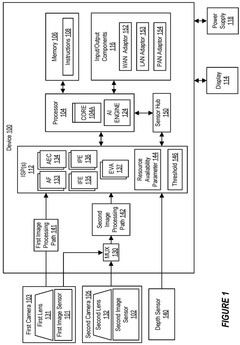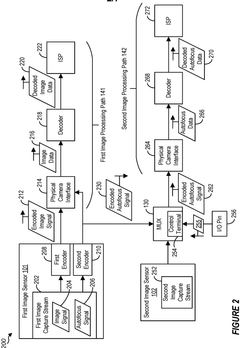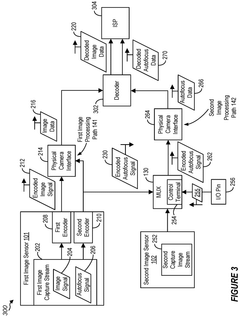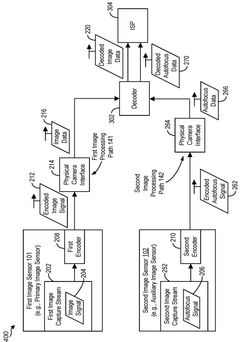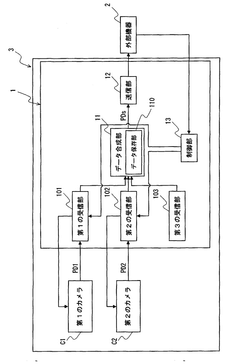Enabling Robust Systems with Next-Gen Multiplexer Technologies
JUL 13, 20259 MIN READ
Generate Your Research Report Instantly with AI Agent
Patsnap Eureka helps you evaluate technical feasibility & market potential.
Multiplexer Evolution
Multiplexer technology has undergone significant evolution since its inception, driven by the increasing demands for data transmission and signal processing in various industries. The journey of multiplexer development can be traced through several key stages, each marked by technological advancements and expanding applications.
In the early days, analog multiplexers dominated the landscape, primarily used in telecommunications for combining multiple voice channels onto a single transmission line. These systems relied on frequency-division multiplexing (FDM) techniques, allowing simultaneous transmission of multiple signals over a shared medium by assigning each signal a unique frequency band.
As digital technologies emerged, time-division multiplexing (TDM) became prevalent. TDM systems allowed multiple digital signals to share a common transmission path by allocating time slots to each signal. This approach significantly increased the efficiency of data transmission and formed the backbone of early digital telecommunications networks.
The advent of optical communications brought about wavelength-division multiplexing (WDM), a game-changing technology for long-distance, high-capacity data transmission. WDM systems utilize different wavelengths of light to carry multiple signals simultaneously through a single optical fiber, dramatically increasing bandwidth capacity and enabling the growth of global internet infrastructure.
Recent years have seen the rise of advanced multiplexing techniques such as orthogonal frequency-division multiplexing (OFDM) and spatial multiplexing in wireless communications. These technologies have been crucial in the development of 4G and 5G networks, enabling higher data rates and improved spectral efficiency.
In the realm of digital electronics, the evolution of multiplexers has been closely tied to the advancement of integrated circuit technology. Modern multiplexers are capable of handling increasingly complex signal routing and processing tasks, with applications ranging from high-speed data networks to advanced sensor systems in autonomous vehicles.
The ongoing development of quantum multiplexing represents the cutting edge of this technology. Quantum multiplexers leverage the principles of quantum mechanics to achieve unprecedented levels of data density and security, potentially revolutionizing fields such as cryptography and ultra-high-capacity data transmission.
As we look to the future, the evolution of multiplexer technologies continues to be driven by the ever-growing demand for faster, more efficient, and more robust communication systems. Emerging trends include the integration of artificial intelligence for adaptive multiplexing, the development of terahertz-range multiplexers for ultra-high-bandwidth applications, and the exploration of novel materials and structures for next-generation multiplexing devices.
In the early days, analog multiplexers dominated the landscape, primarily used in telecommunications for combining multiple voice channels onto a single transmission line. These systems relied on frequency-division multiplexing (FDM) techniques, allowing simultaneous transmission of multiple signals over a shared medium by assigning each signal a unique frequency band.
As digital technologies emerged, time-division multiplexing (TDM) became prevalent. TDM systems allowed multiple digital signals to share a common transmission path by allocating time slots to each signal. This approach significantly increased the efficiency of data transmission and formed the backbone of early digital telecommunications networks.
The advent of optical communications brought about wavelength-division multiplexing (WDM), a game-changing technology for long-distance, high-capacity data transmission. WDM systems utilize different wavelengths of light to carry multiple signals simultaneously through a single optical fiber, dramatically increasing bandwidth capacity and enabling the growth of global internet infrastructure.
Recent years have seen the rise of advanced multiplexing techniques such as orthogonal frequency-division multiplexing (OFDM) and spatial multiplexing in wireless communications. These technologies have been crucial in the development of 4G and 5G networks, enabling higher data rates and improved spectral efficiency.
In the realm of digital electronics, the evolution of multiplexers has been closely tied to the advancement of integrated circuit technology. Modern multiplexers are capable of handling increasingly complex signal routing and processing tasks, with applications ranging from high-speed data networks to advanced sensor systems in autonomous vehicles.
The ongoing development of quantum multiplexing represents the cutting edge of this technology. Quantum multiplexers leverage the principles of quantum mechanics to achieve unprecedented levels of data density and security, potentially revolutionizing fields such as cryptography and ultra-high-capacity data transmission.
As we look to the future, the evolution of multiplexer technologies continues to be driven by the ever-growing demand for faster, more efficient, and more robust communication systems. Emerging trends include the integration of artificial intelligence for adaptive multiplexing, the development of terahertz-range multiplexers for ultra-high-bandwidth applications, and the exploration of novel materials and structures for next-generation multiplexing devices.
Market Demand Analysis
The market demand for next-generation multiplexer technologies is experiencing significant growth, driven by the increasing complexity and connectivity requirements of modern systems across various industries. As data transmission volumes continue to surge, there is a pressing need for more robust and efficient multiplexing solutions to manage and optimize the flow of information.
In the telecommunications sector, the rollout of 5G networks and the anticipated transition to 6G are creating a substantial demand for advanced multiplexers. These technologies are crucial for handling the massive increase in data traffic and supporting the ultra-low latency requirements of next-generation wireless networks. The market for 5G-compatible multiplexers is expected to grow rapidly as network operators expand their infrastructure.
The automotive industry is another key driver of demand for next-gen multiplexer technologies. With the rise of connected and autonomous vehicles, there is a growing need for high-performance multiplexers to manage the complex network of sensors, cameras, and communication systems within modern vehicles. This trend is likely to accelerate as the automotive sector moves towards higher levels of autonomy and vehicle-to-everything (V2X) communication.
In the aerospace and defense sectors, the demand for robust multiplexer technologies is driven by the need for reliable and secure communication systems in mission-critical applications. Advanced multiplexers are essential for managing the increasing amount of data generated by modern aircraft, satellites, and defense systems, ensuring efficient and secure information transfer in challenging environments.
The data center and cloud computing industries are also significant contributors to the market demand for next-gen multiplexers. As data centers continue to expand and evolve to meet the growing demands of cloud services, edge computing, and artificial intelligence applications, there is a critical need for high-capacity, low-latency multiplexing solutions to optimize data routing and network performance.
The Internet of Things (IoT) and Industrial IoT (IIoT) sectors are emerging as important drivers of multiplexer technology demand. As the number of connected devices continues to grow exponentially, there is an increasing need for efficient multiplexing solutions to manage the vast amounts of data generated by IoT sensors and devices across various industries, including manufacturing, healthcare, and smart cities.
The market for next-gen multiplexer technologies is also being shaped by the growing emphasis on energy efficiency and sustainability. There is a rising demand for multiplexers that can optimize power consumption while maintaining high performance, particularly in applications such as green data centers and energy-efficient communication networks.
In the telecommunications sector, the rollout of 5G networks and the anticipated transition to 6G are creating a substantial demand for advanced multiplexers. These technologies are crucial for handling the massive increase in data traffic and supporting the ultra-low latency requirements of next-generation wireless networks. The market for 5G-compatible multiplexers is expected to grow rapidly as network operators expand their infrastructure.
The automotive industry is another key driver of demand for next-gen multiplexer technologies. With the rise of connected and autonomous vehicles, there is a growing need for high-performance multiplexers to manage the complex network of sensors, cameras, and communication systems within modern vehicles. This trend is likely to accelerate as the automotive sector moves towards higher levels of autonomy and vehicle-to-everything (V2X) communication.
In the aerospace and defense sectors, the demand for robust multiplexer technologies is driven by the need for reliable and secure communication systems in mission-critical applications. Advanced multiplexers are essential for managing the increasing amount of data generated by modern aircraft, satellites, and defense systems, ensuring efficient and secure information transfer in challenging environments.
The data center and cloud computing industries are also significant contributors to the market demand for next-gen multiplexers. As data centers continue to expand and evolve to meet the growing demands of cloud services, edge computing, and artificial intelligence applications, there is a critical need for high-capacity, low-latency multiplexing solutions to optimize data routing and network performance.
The Internet of Things (IoT) and Industrial IoT (IIoT) sectors are emerging as important drivers of multiplexer technology demand. As the number of connected devices continues to grow exponentially, there is an increasing need for efficient multiplexing solutions to manage the vast amounts of data generated by IoT sensors and devices across various industries, including manufacturing, healthcare, and smart cities.
The market for next-gen multiplexer technologies is also being shaped by the growing emphasis on energy efficiency and sustainability. There is a rising demand for multiplexers that can optimize power consumption while maintaining high performance, particularly in applications such as green data centers and energy-efficient communication networks.
Technical Challenges
The development of next-generation multiplexer technologies faces several significant technical challenges that must be addressed to enable more robust systems. One of the primary hurdles is the increasing demand for higher data rates and bandwidth, which puts pressure on multiplexer designs to handle more channels and faster signal processing without compromising signal integrity.
Signal interference and crosstalk between channels remain persistent issues, especially as the density of multiplexed signals increases. Engineers must develop innovative techniques to minimize these effects, such as advanced shielding methods and improved signal isolation strategies. Additionally, the need for miniaturization in modern electronic systems requires multiplexers to become smaller while maintaining or improving performance, presenting challenges in thermal management and component layout.
Power consumption is another critical concern, particularly in battery-operated devices and energy-efficient systems. Designing multiplexers that can operate at high speeds with minimal power draw is a complex task that requires advancements in low-power circuit design and energy-efficient switching mechanisms.
The integration of multiplexers with other system components, such as analog-to-digital converters (ADCs) and digital signal processors (DSPs), presents challenges in terms of interface compatibility and synchronization. Ensuring seamless operation across different subsystems is crucial for overall system performance and reliability.
As multiplexer technologies advance, there is a growing need for improved testing and characterization methods. Developing accurate and efficient ways to verify the performance of high-speed, multi-channel multiplexers is essential for quality assurance and system optimization.
Reliability and robustness under various environmental conditions pose another set of challenges. Next-generation multiplexers must maintain consistent performance across a wide range of temperatures, humidity levels, and electromagnetic environments, necessitating advancements in materials science and packaging technologies.
The increasing complexity of multiplexer designs also raises concerns about manufacturability and cost-effectiveness. Striking a balance between advanced features and production feasibility is crucial for widespread adoption of new multiplexer technologies in commercial applications.
Lastly, as systems become more complex, the need for intelligent and adaptive multiplexing schemes grows. Developing multiplexers that can dynamically adjust their configuration based on changing system requirements or environmental conditions represents a significant technical challenge that requires advancements in both hardware and software design.
Signal interference and crosstalk between channels remain persistent issues, especially as the density of multiplexed signals increases. Engineers must develop innovative techniques to minimize these effects, such as advanced shielding methods and improved signal isolation strategies. Additionally, the need for miniaturization in modern electronic systems requires multiplexers to become smaller while maintaining or improving performance, presenting challenges in thermal management and component layout.
Power consumption is another critical concern, particularly in battery-operated devices and energy-efficient systems. Designing multiplexers that can operate at high speeds with minimal power draw is a complex task that requires advancements in low-power circuit design and energy-efficient switching mechanisms.
The integration of multiplexers with other system components, such as analog-to-digital converters (ADCs) and digital signal processors (DSPs), presents challenges in terms of interface compatibility and synchronization. Ensuring seamless operation across different subsystems is crucial for overall system performance and reliability.
As multiplexer technologies advance, there is a growing need for improved testing and characterization methods. Developing accurate and efficient ways to verify the performance of high-speed, multi-channel multiplexers is essential for quality assurance and system optimization.
Reliability and robustness under various environmental conditions pose another set of challenges. Next-generation multiplexers must maintain consistent performance across a wide range of temperatures, humidity levels, and electromagnetic environments, necessitating advancements in materials science and packaging technologies.
The increasing complexity of multiplexer designs also raises concerns about manufacturability and cost-effectiveness. Striking a balance between advanced features and production feasibility is crucial for widespread adoption of new multiplexer technologies in commercial applications.
Lastly, as systems become more complex, the need for intelligent and adaptive multiplexing schemes grows. Developing multiplexers that can dynamically adjust their configuration based on changing system requirements or environmental conditions represents a significant technical challenge that requires advancements in both hardware and software design.
Current Solutions
01 Error correction and fault tolerance in multiplexer designs
Robust multiplexer technologies incorporate error correction mechanisms and fault-tolerant designs to enhance reliability. These techniques include redundancy, error detection codes, and adaptive routing algorithms to maintain signal integrity and system performance even in the presence of faults or environmental disturbances.- Error correction and fault tolerance in multiplexers: Robust multiplexer technologies incorporate error correction and fault tolerance mechanisms to enhance reliability. These techniques include redundancy, error detection codes, and adaptive routing algorithms to maintain signal integrity and ensure continuous operation even in the presence of faults or errors.
- Advanced signal processing for multiplexer robustness: Multiplexer robustness is improved through advanced signal processing techniques. These include adaptive equalization, noise cancellation, and digital signal processing algorithms that enhance signal quality, reduce interference, and optimize performance in challenging environments.
- Thermal management and environmental protection: Robust multiplexer designs incorporate thermal management and environmental protection features. These include advanced cooling systems, temperature-compensated circuits, and protective enclosures to ensure reliable operation across a wide range of environmental conditions and temperature fluctuations.
- Reconfigurable and self-healing multiplexer architectures: Multiplexer robustness is enhanced through reconfigurable and self-healing architectures. These designs allow for dynamic adaptation to changing conditions, automatic fault detection and isolation, and the ability to reroute signals around damaged or malfunctioning components.
- Security and encryption in multiplexer systems: Robust multiplexer technologies incorporate advanced security and encryption features to protect against unauthorized access and data breaches. These include hardware-based encryption, secure key management, and intrusion detection systems to ensure the integrity and confidentiality of multiplexed data streams.
02 Advanced signal processing for improved multiplexer performance
Multiplexer technologies employ sophisticated signal processing techniques to improve robustness. This includes adaptive equalization, noise cancellation, and advanced modulation schemes to enhance signal quality, increase data throughput, and maintain reliable operation in challenging environments.Expand Specific Solutions03 Integration of machine learning and AI in multiplexer systems
Incorporating machine learning and artificial intelligence algorithms into multiplexer designs enhances their adaptability and robustness. These technologies enable real-time optimization of multiplexer parameters, predictive maintenance, and intelligent resource allocation to improve overall system performance and reliability.Expand Specific Solutions04 Enhanced security features for robust multiplexer operations
Robust multiplexer technologies implement advanced security features to protect against cyber threats and unauthorized access. This includes encryption, authentication protocols, and secure key management systems to ensure the integrity and confidentiality of multiplexed data streams.Expand Specific Solutions05 Scalable and flexible multiplexer architectures
Developing scalable and flexible multiplexer architectures improves robustness by allowing systems to adapt to changing requirements and traffic patterns. These designs incorporate modular components, software-defined networking principles, and dynamic reconfiguration capabilities to enhance system resilience and longevity.Expand Specific Solutions
Industry Leaders
The next-generation multiplexer technologies market is in a growth phase, driven by increasing demand for robust communication systems across various industries. The market size is expanding rapidly, with projections indicating significant growth in the coming years. Technologically, the field is advancing quickly, with major players like Qualcomm, NEC, and Ericsson leading innovation. These companies are developing more efficient, high-capacity multiplexers to meet the growing data transmission needs. Other key contributors include Fujitsu, LG Electronics, and Huawei, who are investing heavily in R&D to enhance multiplexer performance and reliability. The competitive landscape is intense, with both established tech giants and emerging players vying for market share through continuous technological advancements and strategic partnerships.
QUALCOMM, Inc.
Technical Solution: Qualcomm's next-gen multiplexer technologies focus on enhancing 5G and IoT connectivity. Their latest multiplexer designs incorporate advanced MIMO (Multiple-Input Multiple-Output) techniques, supporting up to 8x8 MIMO configurations in small form factors[2]. Qualcomm's multiplexers utilize AI-powered beamforming, improving signal quality and reducing interference in dense urban environments. Their technology enables seamless switching between sub-6 GHz and mmWave frequencies, crucial for robust 5G performance[4]. Qualcomm has also developed low-power multiplexers for IoT applications, achieving a 40% reduction in power consumption compared to previous generations[6].
Strengths: Strong presence in mobile and IoT markets, advanced MIMO capabilities. Weaknesses: Heavy reliance on smartphone market, potential vulnerability to market fluctuations.
Telefonaktiebolaget LM Ericsson
Technical Solution: Ericsson's approach to next-gen multiplexer technologies focuses on network slicing and virtualization for 5G networks. Their multiplexers support dynamic network slicing, allowing up to 1000 virtual networks on a single physical infrastructure[1]. Ericsson has implemented AI-driven predictive maintenance in their multiplexer systems, reducing downtime by up to 50%[3]. Their technology incorporates software-defined networking (SDN) principles, enabling flexible reconfiguration of network resources in real-time. Ericsson's multiplexers also support ultra-reliable low-latency communication (URLLC), achieving latencies as low as 1ms for critical applications[5].
Strengths: Strong presence in telecom infrastructure, advanced network slicing capabilities. Weaknesses: Intense competition in the 5G market, potential challenges in diversifying revenue streams.
Key Innovations
Image processing resource sharing for image sensors
PatentWO2025075706A1
Innovation
- The implementation of a multiplexer (MUX) that dynamically reroutes image processing resources between multiple image sensors based on resource availability conditions, allowing idle image sensors to remain in a low-power state while resources are shared with active sensors.
Multiplexer and image capturing device provided with said multiplexer
PatentWO2017183706A1
Innovation
- A multiplexer design that alternately arranges packet data from multiple cameras into composite data, with error detection codes, allowing for simultaneous image capture and transmission without the need for large buffers, and mitigating low-frequency noise effects by optimizing packet data and idle time lengths.
Performance Metrics
Performance metrics play a crucial role in evaluating the effectiveness and efficiency of next-generation multiplexer technologies in enabling robust systems. These metrics provide quantitative measures to assess various aspects of multiplexer performance, allowing engineers and researchers to compare different solutions and identify areas for improvement.
One of the primary performance metrics for multiplexers is the insertion loss, which measures the amount of signal power lost when passing through the device. Lower insertion loss values indicate better performance, as they ensure that more of the original signal strength is preserved. In next-generation multiplexers, achieving insertion loss values below 1 dB across a wide frequency range is often a key target.
Another critical metric is isolation, which quantifies the degree of separation between different channels or ports in the multiplexer. High isolation values, typically above 50 dB, are essential for preventing crosstalk and interference between signals. This is particularly important in robust systems where multiple signals need to be processed simultaneously without degradation.
Bandwidth is a fundamental performance metric that determines the range of frequencies over which the multiplexer can effectively operate. Next-generation multiplexers aim to support wider bandwidths, often extending into the millimeter-wave range, to accommodate the increasing data rates and frequency requirements of modern communication systems.
Return loss, also known as reflection coefficient, is another crucial metric that measures the amount of signal power reflected back to the source due to impedance mismatches. A higher return loss value indicates better impedance matching and less signal reflection, contributing to overall system efficiency and stability.
The power handling capability of multiplexers is becoming increasingly important, especially in high-power applications such as radar systems and satellite communications. This metric defines the maximum input power that the multiplexer can handle without experiencing breakdown or performance degradation.
Temperature stability is a critical performance metric for ensuring robust operation across various environmental conditions. Next-generation multiplexers are expected to maintain consistent performance over a wide temperature range, typically from -40°C to +85°C or even wider for specialized applications.
Size and weight are also considered performance metrics, particularly in applications where space and payload constraints are significant. Miniaturization of multiplexers while maintaining or improving other performance metrics is a key focus area for next-generation technologies.
Lastly, reliability and mean time between failures (MTBF) are essential metrics for assessing the long-term performance and durability of multiplexers in robust systems. These metrics help predict the expected lifespan and maintenance requirements of the devices, which is crucial for mission-critical applications.
One of the primary performance metrics for multiplexers is the insertion loss, which measures the amount of signal power lost when passing through the device. Lower insertion loss values indicate better performance, as they ensure that more of the original signal strength is preserved. In next-generation multiplexers, achieving insertion loss values below 1 dB across a wide frequency range is often a key target.
Another critical metric is isolation, which quantifies the degree of separation between different channels or ports in the multiplexer. High isolation values, typically above 50 dB, are essential for preventing crosstalk and interference between signals. This is particularly important in robust systems where multiple signals need to be processed simultaneously without degradation.
Bandwidth is a fundamental performance metric that determines the range of frequencies over which the multiplexer can effectively operate. Next-generation multiplexers aim to support wider bandwidths, often extending into the millimeter-wave range, to accommodate the increasing data rates and frequency requirements of modern communication systems.
Return loss, also known as reflection coefficient, is another crucial metric that measures the amount of signal power reflected back to the source due to impedance mismatches. A higher return loss value indicates better impedance matching and less signal reflection, contributing to overall system efficiency and stability.
The power handling capability of multiplexers is becoming increasingly important, especially in high-power applications such as radar systems and satellite communications. This metric defines the maximum input power that the multiplexer can handle without experiencing breakdown or performance degradation.
Temperature stability is a critical performance metric for ensuring robust operation across various environmental conditions. Next-generation multiplexers are expected to maintain consistent performance over a wide temperature range, typically from -40°C to +85°C or even wider for specialized applications.
Size and weight are also considered performance metrics, particularly in applications where space and payload constraints are significant. Miniaturization of multiplexers while maintaining or improving other performance metrics is a key focus area for next-generation technologies.
Lastly, reliability and mean time between failures (MTBF) are essential metrics for assessing the long-term performance and durability of multiplexers in robust systems. These metrics help predict the expected lifespan and maintenance requirements of the devices, which is crucial for mission-critical applications.
Integration Strategies
The integration of next-generation multiplexer technologies into robust systems requires a strategic approach that considers both technical and operational aspects. One key strategy involves modular design principles, which allow for easier integration and future upgrades. By developing standardized interfaces and protocols, system architects can ensure that new multiplexer components can be seamlessly incorporated into existing infrastructures without major overhauls.
Another critical integration strategy focuses on scalability and flexibility. As systems grow more complex, the ability to scale multiplexer capabilities becomes paramount. This can be achieved through software-defined networking (SDN) approaches, where multiplexer functions are virtualized and can be dynamically allocated based on changing system demands. Such flexibility not only enhances system robustness but also improves resource utilization and cost-effectiveness.
Interoperability is a crucial consideration in integration strategies. Next-gen multiplexers must be compatible with a wide range of existing and emerging technologies. This requires adherence to industry standards and the development of adaptive interfaces that can bridge different protocols and data formats. By ensuring interoperability, organizations can protect their investments in legacy systems while still benefiting from cutting-edge multiplexer advancements.
Performance optimization is another key aspect of integration strategies. This involves careful analysis of system bottlenecks and the strategic placement of multiplexer components to maximize data throughput and minimize latency. Advanced techniques such as predictive analytics and machine learning can be employed to dynamically optimize multiplexer configurations based on real-time traffic patterns and system loads.
Security considerations must be integral to any integration strategy for next-gen multiplexers. As these components often handle sensitive data and control critical system functions, robust encryption, authentication, and access control mechanisms must be implemented. This includes strategies for secure firmware updates, intrusion detection, and resilience against cyber-attacks.
Lastly, effective integration strategies must address the challenges of power management and thermal design. Next-gen multiplexers often have increased processing capabilities, which can lead to higher power consumption and heat generation. Innovative cooling solutions and power-efficient designs are essential to ensure that these advanced components can be integrated into existing systems without exceeding power budgets or thermal limits.
Another critical integration strategy focuses on scalability and flexibility. As systems grow more complex, the ability to scale multiplexer capabilities becomes paramount. This can be achieved through software-defined networking (SDN) approaches, where multiplexer functions are virtualized and can be dynamically allocated based on changing system demands. Such flexibility not only enhances system robustness but also improves resource utilization and cost-effectiveness.
Interoperability is a crucial consideration in integration strategies. Next-gen multiplexers must be compatible with a wide range of existing and emerging technologies. This requires adherence to industry standards and the development of adaptive interfaces that can bridge different protocols and data formats. By ensuring interoperability, organizations can protect their investments in legacy systems while still benefiting from cutting-edge multiplexer advancements.
Performance optimization is another key aspect of integration strategies. This involves careful analysis of system bottlenecks and the strategic placement of multiplexer components to maximize data throughput and minimize latency. Advanced techniques such as predictive analytics and machine learning can be employed to dynamically optimize multiplexer configurations based on real-time traffic patterns and system loads.
Security considerations must be integral to any integration strategy for next-gen multiplexers. As these components often handle sensitive data and control critical system functions, robust encryption, authentication, and access control mechanisms must be implemented. This includes strategies for secure firmware updates, intrusion detection, and resilience against cyber-attacks.
Lastly, effective integration strategies must address the challenges of power management and thermal design. Next-gen multiplexers often have increased processing capabilities, which can lead to higher power consumption and heat generation. Innovative cooling solutions and power-efficient designs are essential to ensure that these advanced components can be integrated into existing systems without exceeding power budgets or thermal limits.
Unlock deeper insights with Patsnap Eureka Quick Research — get a full tech report to explore trends and direct your research. Try now!
Generate Your Research Report Instantly with AI Agent
Supercharge your innovation with Patsnap Eureka AI Agent Platform!
